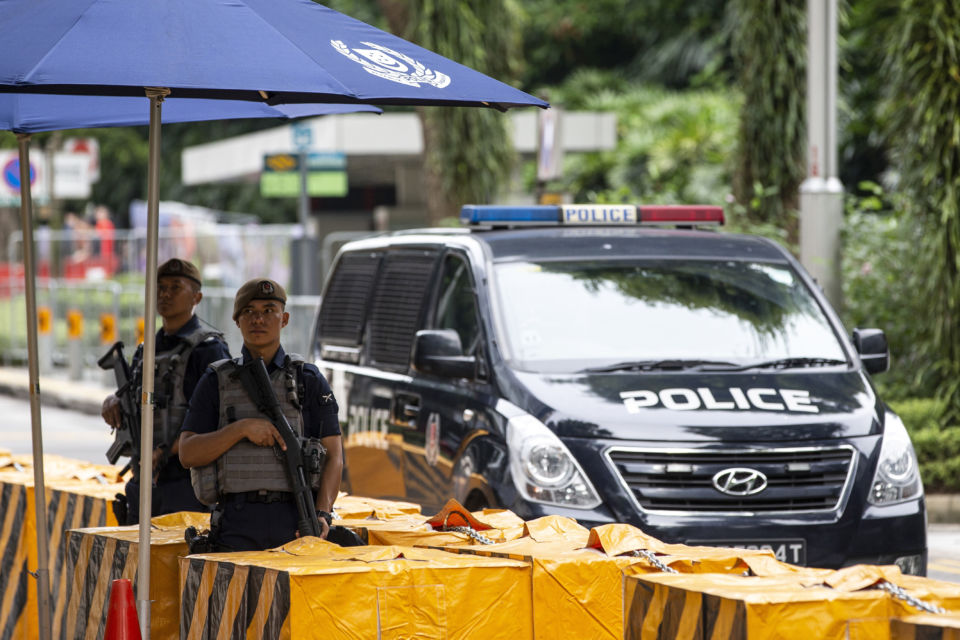The key players are now in position in Singapore. DPRK leader Kim Jong Un is arriving first, and Air Force One carrying U.S. President Donald Trump is half-way around the world for the key face-to-face meeting.
CGTN’s Sean Callebs explains what’s at stake.
A year ago, the U.S. was talking about a preemptive military strike against Pyongyang. Now there’s been a remarkable change in tone.
“We were at the height of tensions, both rhetorically, but in real terms too. We were moving military assets into the region. I don’t think it was just a threat. I think it was being seriously considered,” U.S. Foreign Policy Expert Suzanne Dimaggio of the New America think tank said.
Security is tight on Singapore’s island of Sentosa. It’s been the sight of a Japanese prisoner of war camp, but now it’s a tourist attraction. This week, it’s also the site of the one-day summit.

In this June 10, 2018, file photo, Gurkha police officers stand guard outside the St. Regis Hotel in Singapore ahead of the summit between U.S. President Donald Trump and DPRK leader Kim Jong Un. (AP Photo/Yong Teck Lim, File)
“You have two strong leaders here, both highly charismatic in their own way,” Professor Arthur Dong of Georgetown University’s McDonough School of Business said. “And unpredictable.”
So what will it take for the DPRK and the U.S. to leave Singapore calling the talks a success?
“I think Kim Jong Un, first of all, wants to stand shoulder-to-shoulder with the president. It would be an indication he is coming into negotiations on equal footing,” Dimaggio said.

North Korean leader Kim Jong-Un (C) walks on the Jubilee bridge during a tour in Singapore on June 11, 2018. North Korean leader Kim Jong Un took a night-time stroll around some of Singapore’s sights late June 11, 2018 ahead of his summit with US President Donald Trump. (AFP PHOTO / Nicholas YEO)
It would also indicate that the DPRK is a nation that is a budding nuclear power, but that’s exactly what Donald Trump is trying to end.
“The best-case scenario is that we see a gradual transformation of the DPRK, and when I say gradual I don’t think things will happen overnight, but we at least need a dialogue. A failure would be both sides just completely rejecting all the progress that has been made up to this point. And a condition for further engagement, and denuclearization by a certain time period,” Professor Dong said.

A handout photo taken by Ministry of Communications and Information of Singapore on June 11, 2018 shows US President Donald Trump (L) listening to Singapore’s Prime Minister Lee Hsien Loong (R) during his visit to The Istana, the official residence of the prime minister, in Singapore. (AFP PHOTO / Ministry of Communications and Information of Singapore)
Singapore also provides a chance for Donald Trump to forge a relationship with Kim Jong Un. Foreign policy experts have said it is a rare chance to talk about Germany, Vietnam. and Japan. These are nations the U.S. once faced on the battlefield and now counts as friends.
If the two leaders can see eye-to-eye, there is a chance the DPRK and the U.S. could go down that same path eventually.
Understanding the turbulent history between the US and DPRK
Washington and Pyongyang have shifted from containment to engagement several times spanning nearly seven decades. But what caused the strain? CGTN’s Sean Callebs explains the complicated history.
 CGTN America
CGTN America
 A man watches a TV screen showing file footage of U.S. President Donald Trump, right, and North Korean leader Kim Jong Un during a news program at the Seoul Railway Station in Seoul, South Korea, Monday, June 11, 2018. (AP Photo/Ahn Young-joon)
A man watches a TV screen showing file footage of U.S. President Donald Trump, right, and North Korean leader Kim Jong Un during a news program at the Seoul Railway Station in Seoul, South Korea, Monday, June 11, 2018. (AP Photo/Ahn Young-joon)
